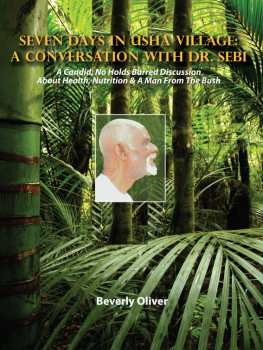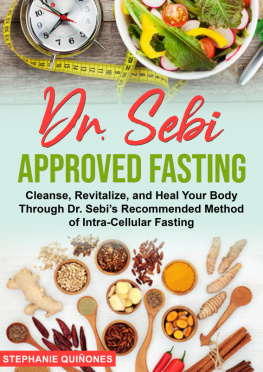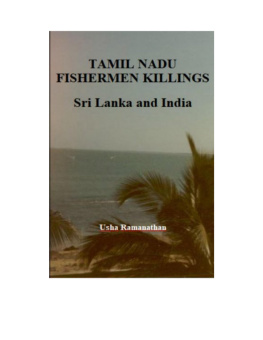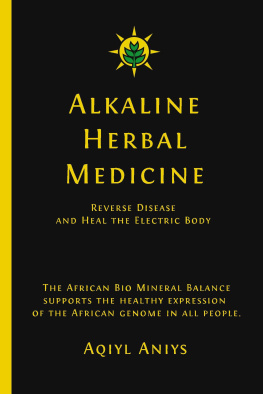Seven Days in Usha Village:
A Conversation with Dr. Sebi
Beverly Oliver
Copyright 2007 Beverly Oliver
All rights reserved
Distributed by Smashwords
No part of this book may be reproduced or transmittedin any form or by any means, electronic or mechanical, includingphotocopying, recording, or by any information storage andretrieval system, without permission in writing from the publisher.Brief quotations may be used in literary reviews.
Cover Design by Robert Porter
Ebook formatting by www.ebooklaunch.com
ACKNOWLEDGMENTS
An adaptation of John Donnes Meditation17 says No man is an island, no man stands alone. And withthat in mind I thank the following individuals for theircooperation, creativity and editorial expertise: Robert Porter,Steve Jones, Wanda Thomas and Michael Barto. Xave Bowman and NinaTaylor-Collins assured an unbroken line of communication at Dr.Sebis Office, Inc. and Im most grateful for the connection. Andof course I give many thanks to the source, the green light forthis book, Dr. Sebi and his wife Matun (Patricia Bowman), whosegenerosity and dedication to healing remain impeccable. To theCreator of our vast, wonderful Universe thank you, thank you, athousand times thank you for this Journey.
CONTENTS
I met him in Washington, DC in the early1980s when I produced public affairs features for WHUR-FM, andshortly after his transition from Alfredo Bowman the steam engineerto Dr. Sebi the herbalist. My own gynecological concerns were anissue at the time and I shared my feelings with colleagues at thestation. One in particular, an engineer and vegetarian named JohnDavies, suggested I meet a man who might remedy my problems. Idecided to see him instead of having a laparoscopy.
When I saw him for the first time at theCommunity Warehouse in DC, Dr. Sebi stood tall, slender,statuesque, much like a Maasai tribesman in East Africa. When hespoke, English words flowed clearly and robustly from his YulBrynner-sounding voice even though his first language is Spanish.And his persona, as I recall, resembled Mr. Brynners character,the King of Siam, in the film The King and I.
Words about natural and unnatural foods andhis analogies of human and animal physiology, especially gorillasand polar bears, pulsated throughout the room. No microphone orbull horn needed. Some listeners sat surprised by his lecture,interjecting soft murmurs of doubt. Others willingly and intentlyreceived the message. I was one of them, and because I felt an evenlarger audience should hear Dr. Sebis perspective on health andnutrition, I invited him to WHUR to speak in a four-part radioseries on herbs and natural healing. He came.
We recorded a session a little over an hourand as I think back, it was a difficult edit. You just cant put itall in the program, no matter how great or informative. The finalcut yielded four 10-minute shows with theme music by Lonnie ListonSmith. WHUR broadcast the series in the newsmagazine The SundayDigest.
Subsequently, throughout the mid-80s Itraveled to New York City to hear Dr. Sebis lectures. After thatperiod my career path changed somewhat, taking me out of the EastCoast. The New York Attorney Generals office attempted to changeDr. Sebis in 1987 when it arrested and jailed him for refusing toremove unlicensed medical claims from New York City newspapersThe Amsterdam News and The Village Voice. Hisadvertisements promoted cures for AIDS, asthma, cancer, and sicklecell anemia. He won his case in 1988, continued to treat clientswith his products, but would eventually relocate his office. Twentyyears would pass before Dr. Sebi and I reconnected. That happenedin 2005 in Los Angeles, California, two years after I moved to theWest Coast to continue my career as a writer and creativeartist.
In our first conversation since reconnectingI asked him why he hadnt written about his knowledge of health andnutrition. Lo and behold he pulled out a manuscript, a draft of hisautobiography. Words cannot fully explain how I felt that moment.Such a thrill to know the public can now have a reference book ofmore than 25 years experience in nutrition and natural healing fromDr. Sebis perspective and experiences.
I was equally moved when asked to assistwith his work-in-progress, thus, the reason for the seven-dayinterview in Usha Village and La Ceiba, Honduras November 6-12,2005. Reading this book, Seven Days in Usha Village: AConversation with Dr. Sebi, you experience part of thatsojourn.
Mountains filled with lush, dark greentropical trees and plants surround Dr. Sebis Usha Village, ahealing center in a town called Agua Caliente, 24 miles east of LaCeiba. His thermal hot spring runs from the mountains straight downto the middle of his 14 cabinshe calls them huts. An African maskhangs over the yellow hut once occupied by the late hip hop singerLisa Left Eye Lopes. Like others before her, she sought healingand contemplation at Usha Village.
Several mornings I stepped outside my cabinand experienced a natural pedicure as warm waters from the hotspring flowed over my bare feet. I usually use a cream moisturizeron my feet after bathing. No need for that at the village.
The hot spring is also the source for Dr.Sebis sauna and bath houses. One of its healing properties is theexistence of sulfur (p. 67), beneficial in treating AIDS andlung cancer.
Never in my life have I known a man sopassionate about herbs and plants that hell stop driving a vehicleto go check out one seen from his windshield. He risked going tojail for his curiosity about a plant he saw on private property inBrazil (pp. 85-86). Thats what I learned about Dr. Sebiwhile tape recording the interview and riding around the town of LaCeiba in the back seat of his truck, his wife Matun seated infront.
Speaking of a love affair with plants, Imthe offspring of Southern parents (South Carolina). Imagine myreaction when Dr. Sebi gives the thumbs down to collard greens, aplant Ive eaten since time immemorial (p. 82).
Over the past 20 years Dr. Sebi has advisedand treated many celebrities and community activists. Someexperiences proved invaluable to all involved. Others stirredintense emotions that resurfaced during the seven-day interview(pp. 98, 111). His mother Violet, who recently passed at age92, also witnessed her sons heated energy (p. 112). Butnote Dr. Sebis love for one of the most prominent influences inhis life, his grandmother Mama Hay, for whom his autobiography isnamed (p. 12).
Intense? Yes. Unconventional? Undoubtedly,yet Dr. Sebis generosity remains unquestionable. Evidence of thatis in your hands. Seven Days in Usha Village: A Conversationwith Dr. Sebi precedes Dr. Sebis autobiography, a projectstarted long before this publication. He agreed to go forward withthis book to commemorate the 20th anniversary of winning his courtcase, and as a means of informing his supporters his autobiographyis on the way. Dr. Sebi generously allowed excerpts from TheCure: The Autobiography of Dr. Sebi Mama Hay to be printedhere. Youll read italicized passages from the autobiography thatrelate to topics discussed in the interview. In a way one booksupports the other.
Beverly Oliver
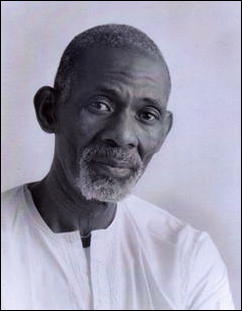
Alfredo Bowman
(Dr. Sebi)
Approximately 45 years ago I made thestatement I want to be useful. I want to do something great forthe Black woman so the world can see how amazing, how beautiful sheis. I remember sitting in a barbers chair in New Orleans in 1960when I made that statement. I was bent on giving her something thatwould elevate her universally. It was a drive that I could notcontain. It came from withinan inner dictate. I didnt know that Iwould have to face the American Medical Association, the Food andDrug Administration and the judicial system of the State of NewYork in representing the gift that I was going to give her, theBlack Woman of the world.

